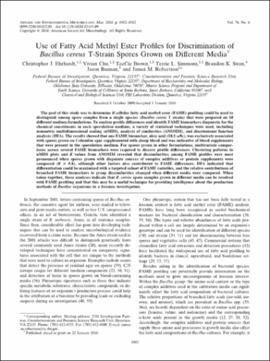| dc.contributor.author | Ehrhardt, Christopher J. | |
| dc.contributor.author | Chu, Vivian | |
| dc.contributor.author | Brown, TeeCie | |
| dc.contributor.author | Simmons, Terrie L. | |
| dc.contributor.author | Swan, Brandon K. | |
| dc.contributor.author | Bannan, Jason | |
| dc.contributor.author | Robertson, James M. | |
| dc.date.accessioned | 2018-08-29T14:24:31Z | |
| dc.date.available | 2018-08-29T14:24:31Z | |
| dc.date.issued | 2010-03 | |
| dc.identifier | oksd_ehrhardt_useoffattyacidm_2010 | |
| dc.identifier.citation | Ehrhardt, C. J., Chu, V., Brown, T., Simmons, T. L., Swan, B. K., Bannan, J., & Robertson, J. M. (2010). Use of fatty acid methyl ester profiles for discrimination of Bacillus cereus T-strain spores grown on different media. Applied and Environmental Microbiology, 76(6), 1902-1912. https://doi.org/10.1128/AEM.02443-09 | |
| dc.identifier.uri | https://hdl.handle.net/11244/301607 | |
| dc.description.abstract | The goal of this study was to determine if cellular fatty acid methyl ester (FAME) profiling could be used to distinguish among spore samples from a single species (Bacillus cereus T strain) that were prepared on 10 different medium formulations. To analyze profile differences and identify FAME biomarkers diagnostic for the chemical constituents in each sporulation medium, a variety of statistical techniques were used, including nonmetric multidimensional scaling (nMDS), analysis of similarities (ANOSIM), and discriminant function analysis (DFA). The results showed that one FAME biomarker, oleic acid (18:1 w9c), was exclusively associated with spores grown on Columbia agar supplemented with sheep blood and was indicative of blood supplements that were present in the sporulation medium. For spores grown in other formulations, multivariate comparisons across several FAME biomarkers were required to discern profile differences. Clustering patterns in nMDS plots and R values from ANOSIM revealed that dissimilarities among FAME profiles were most pronounced when spores grown with disparate sources of complex additives or protein supplements were compared (R > 0.8), although other factors also contributed to FAME differences. DFA indicated that differentiation could be maximized with a targeted subset of FAME variables, and the relative contributions of branched FAME biomarkers to group dissimilarities changed when different media were compared. When taken together, these analyses indicate that B. cereus spore samples grown in different media can be resolved with FAME profiling and that this may be a useful technique for providing intelligence about the production methods of Bacillus organisms in a forensic investigation. | |
| dc.format | application/pdf | |
| dc.language | en_US | |
| dc.publisher | American Society for Microbiology | |
| dc.rights | This material has been previously published. In the Oklahoma State University Library's institutional repository this version is made available through the open access principles and the terms of agreement/consent between the author(s) and the publisher. The permission policy on the use, reproduction or distribution of the material falls under fair use for educational, scholarship, and research purposes. Contact Digital Resources and Discovery Services at lib-dls@okstate.edu or 405-744-9161 for further information. | |
| dc.title | Use of fatty acid methyl ester profiles for discrimination of Bacillus cereus T-strain spores grown on different media | |
| osu.filename | oksd_ehrhardt_useoffattyacidm_2010.pdf | |
| dc.description.peerreview | Peer reviewed | |
| dc.identifier.doi | 10.1128/AEM.02443-09 | |
| dc.description.department | Biochemistry and Molecular Biology | |
| dc.type.genre | Article | |
| dc.type.material | Text | |
| dc.subject.keywords | culture media | |
| dc.subject.keywords | esters | |
| dc.subject.keywords | fatty acids | |
